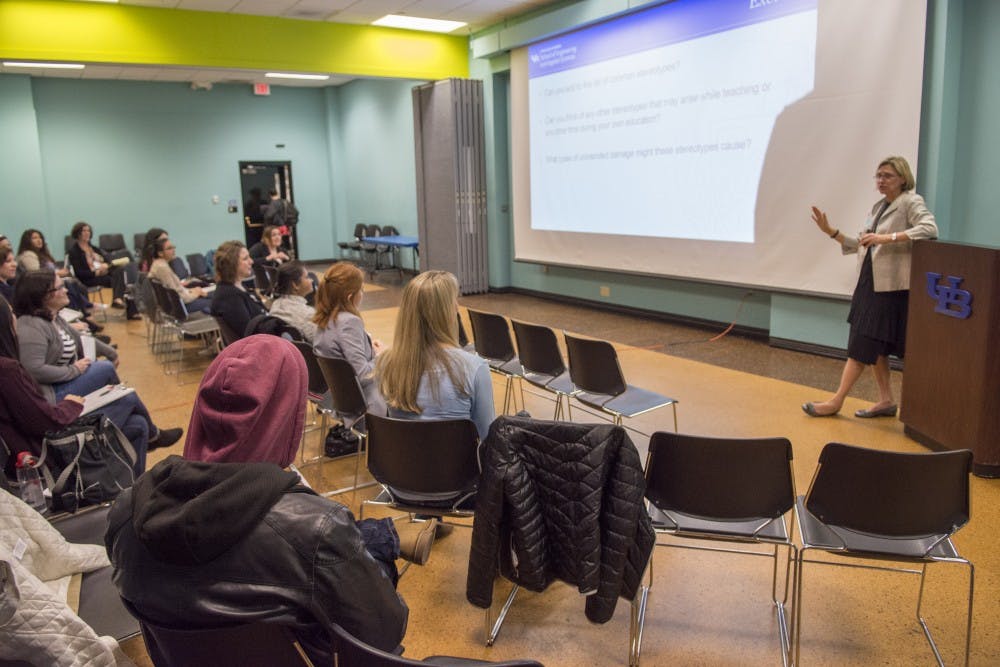Katie Sember thinks twice before saying something too “assertive” or using a tone that might be seen as “intimidating.”
After two years of working as an engineer for local company Liazon, Sember is used to navigating the engineering workforce. She said she always keeps in mind that the rules for her are slightly different. Sember said she takes any chance she gets to attend a conference aimed toward women in the workplace.
Nearly 200 other women – and a few men – joined Sember in attending UB’s third annual Women in STEM Summit on Wednesday. It was a day of reflection, camaraderie and a chance for women in top positions in these fields to share advice for younger generations in science, technology, math and engineering (STEM).
Keynote speaker JJ DiGeronimo drew from her 20 years of experience in computer science and business to give practical tips for women in STEM. The afternoon continued with smaller breakout sessions focused on issues like “being a male ally” or “confronting gender bias in the classroom.” Attendees followed these discussions during a networking hour in the Student Union (SU) over light refreshments.
DiGeronimo said one of the biggest challenges women face in the STEM workplace is a lack of “self-efficacy,” which she defined as “the belief that you can actually achieve something challenging.”
She pointed to a Hewlett-Packard (HP) study that found women only apply for jobs and opportunities for which they meet 100 percent of the qualifications listed. Men by comparison, apply after meeting 60 percent of these qualifications.
The study explained that women are less likely to take career risks until they feel totally qualified, which stems from childhood experiences where girls are more likely told to “take it easy” or to “watch they don’t hurt themselves.”
This cautiousness, while useful in some aspects, translates to less jobs hiring women simply because less women apply for the jobs.
“You belong in this meeting, you belong in this conversation and you have something valuable to add,” DiGeronimo said. “But you can often have these aspirations and yet talk yourself out of achieving before you even get started.”
For this to change, women need to silence the voice in their head that says they aren’t good enough for a position or to run a committee, DiGeronimo said. Women cannot let the word “no” scare them from applying for opportunities, she added.
“Let them tell you no,” DiGeronimo said. “Trust me, they will.”
She also urged women to brag about their accomplishments and find mentors or “career catalysts” to do so for them. Most women expect the quality of their work to “speak for itself,” while men are more likely to boldly network with superiors or ask directly for promotions, DiGeronimo said.
At one point, DiGeronimo recalled a story where a company created a healthcare app, but forgot to include a mechanism for tracking menstruation.
“Unsurprisingly, there were no women on that board,” DiGeronimo said. “We need you in STEM, we need the way women think in STEM.”
After the keynote address, attendees broke off into mini concurrent sessions that covered topics like salary negotiation strategies for women and implicit bias.
Liesl Folks, dean of the college of Science, Engineering and Applied Sciences (SEAS), gave advice on how to change stereotypical narratives and the impact they can have in teaching.
Folks talked about the dangers of stereotype threat – the preconceived idea that someone is judging based on race, gender, sexuality, age or ability. She said the best way to help female and underrepresented minority students who suffer from the risk of stereotype threat is to actively work against these narratives like “white males are better at quantitative analysis” or “Asian students are good at math.”
“It’s not enough to not say anything to your students, you have to be proactive,” Folks said. “They know they’re women, they know they’re black, you have to make statements that actively disrupt their own narratives.”
Women shared experiences of their own, where they were both guilty of bias and were on the receiving end of gender or socioeconomic bias.
Students and alumni attended the summit to network, learn and be inspired.
Judy Moskal entered the engineering field in 1965 and attended the summit to “support student efforts.”
She took a moment to reflect on how STEM fields have improved for women since her career began. Moskal said she remembers leaving a civil-service exam, when a man told her, “even if you get this job, you should turn it down because you need to support your husband.”
“It’s a good thing I didn’t listen,” she laughed. “I divorced my husband soon after and supported myself for the next 30 years.”
Moskal was hired at AT&T as Buffalo’s first female engineer more than 50 years ago. Although she thinks women have a “long way to go,” Moskal said she would give a lot up to be able to start her career now.
The Women in Stem Cooperative will host its next event – a brown-bag lunch discussion in SU – on April 25 at 12 p.m. The event will feature undergraduate and graduate students presenting research on inclusivity and under-representation in various fields.
Sarah Crowley is the senior features editor and can be reached at sarah.crowley@ubspectrum.com





